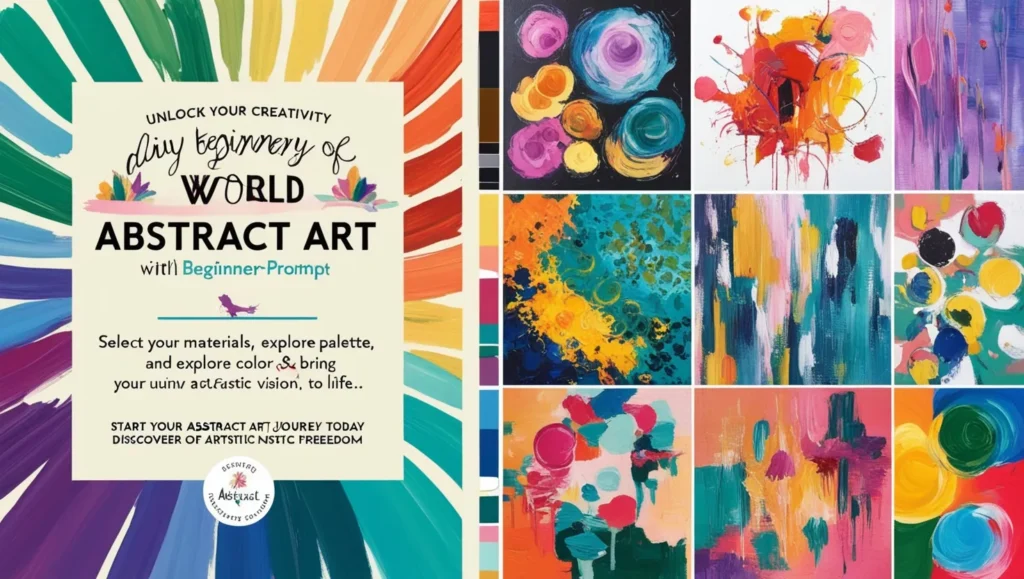Paint Abstract Art for Beginners
Paint Abstract Art for Beginners is a creative and liberating form of expression that allows artists to explore colors, shapes, and emotions without the constraints of realism. It’s an excellent starting point for beginners who want to dive into the world of painting, as it focuses on personal interpretation rather than perfection. If you’ve ever been intrigued by abstract art but didn’t know where to start, this guide is for you.
Understanding Abstract Art
Abstract art is not about replicating reality but expressing feelings, ideas, or concepts through visual elements like color, form, and texture. It often evokes emotions and invites viewers to interpret the artwork in their own way. Paint Abstract Art for Beginners
Key Characteristics:
- Non-representational: Abstract art does not directly depict objects or scenes.
- Emotional Expression: The focus is on evoking a mood or feeling.
- Creativity Over Rules: There’s no right or wrong way to create abstract art.
Materials You’ll Need
Before you start, gather the right tools:
- Canvas: Choose a size you’re comfortable working with.
- Paints: Acrylics are beginner-friendly, as they dry quickly and are easy to handle.
- Brushes: Invest in a variety of sizes for different effects.
- Palette: Use a mixing palette for blending colors.
- Additional Tools: Sponges, palette knives, or even household items like credit cards for unique textures.
Steps to Create Abstract Art
1. Find Your Inspiration
Paint Abstract Art for Beginners often starts with an idea or feeling. Think about what you want to express—joy, chaos, calmness, or excitement. You can also draw inspiration from music, nature, or emotions.
2. Choose Your Color Palette
Colors play a vital role in setting the tone of your artwork. For beginners:
- Start with a limited palette (3-5 colors) to avoid overwhelming your composition.
- Experiment with complementary or contrasting colors for dynamic effects.
3. Prepare Your Workspace
Set up a clutter-free area where you can freely experiment. Cover your workspace with old newspapers or plastic to protect it from spills. Paint Abstract Art for Beginners
4. Experiment with Techniques
Abstract art is all about exploration. Try these techniques:
- Layering: Build depth by layering different colors.
- Dripping and Splattering: Add spontaneity by dripping paint or flicking it onto the canvas.
- Blending: Use brushes or sponges to create smooth transitions between colors.
- Texturing: Use palette knives or other tools to add texture.
5. Start with a Base Layer
Apply a base color or random brushstrokes to cover the canvas. This removes the intimidation of a blank canvas and serves as a foundation for your artwork. Paint Abstract Art for Beginners
6. Let Your Creativity Flow
There are no strict rules in abstract art. Play with shapes, lines, and patterns. Trust your instincts and let your emotions guide your strokes.
7. Step Back and Assess
Periodically step back to view your work from a distance. This helps you see the composition as a whole and decide where to make adjustments.
8. Finish with Details
Once you’re happy with the overall composition, add final touches or highlights to bring your painting to life.
Tips for Beginners
- Embrace Imperfection: Abstract art is about self-expression, not precision.
- Experiment Boldly: Don’t be afraid to try unconventional tools or techniques.
- Learn from Others: Study the works of famous abstract artists like Jackson Pollock or Wassily Kandinsky for inspiration.
- Practice Regularly: The more you paint, the more confident you’ll become.
Overcoming Challenges
- Fear of Starting: Remind yourself that abstract art is subjective—there’s no way to fail.
- Overthinking: Trust your instincts and let the process be organic.
- Messy Results: Embrace the chaos; abstract art thrives on unpredictability.
Displaying Your Artwork
Once your piece is complete, consider these options to showcase your work:
- Framing: Frame your painting for a polished look.
- Home Décor: Display it on a wall to personalize your living space.
- Gifting: Abstract art makes a thoughtful, one-of-a-kind gift.
Final Thoughts
Abstract art is a journey of self-discovery and creativity. As a beginner, focus on the joy of creating rather than the end result. With practice and experimentation, you’ll find your unique style and gain confidence in your artistic abilities.
Pick up your brushes, unleash your imagination, and start painting your first abstract masterpiece today!

